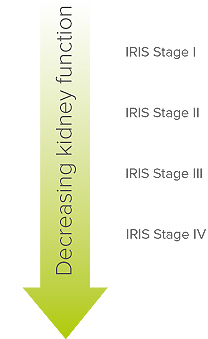What is chronic kidney failure (CKD)?
Kidney failure means that both kidneys are not functioning effectively. Most often it is detected either by an increase in kidney values on bloods, urine testing or a combination of the two.
Kidney failure is defined as ‘chronic’ when the kidneys have not been functioning normally for at least three months. CKD is not reversible and in most cases will progress with time.
There are many different causes of CKD including chronic inflammation, protein loss through the kidneys, malformation at birth and inherited diseases such as polycystic kidney disease in certain cat breeds.
What are the consequences of CKD?
The kidneys are responsible for a number of very important processes such as eliminating waste products from the blood stream, maintaining normal water and blood salt (electrolyte) balance and certain hormone production. CKD can therefore result in disturbance of these vital functions and most commonly gradual build-up of toxins within the blood stream. Blood pressure can also become affected (often increased) which can in itself cause further damage to the kidneys.
How is chronic kidney failure diagnosed?
CKD is normally diagnosed through a combination of history, physical examination, blood results and urine results. Additional tests such as blood pressure, culture and abdominal ultrasound are often performed.
Traditionally we use blood markers such as urea and creatinine to diagnose and monitor the condition however there are newer more sensitive markers such as ‘SDMA’ which are helping us to detect the condition earlier.
Unfortunately these tests are still largely insensitive and currently with routine bloods/urine testing, we are only able to detect that our patients have kidney failure when 66% or more of the kidneys are not functioning normally.
When we are certain that a patient has chronic and not acute kidney failure we can ‘stage’ the patient according to the IRIS staging system. This was devised by a group of experts in the field and means that researchers can group patients together based on similar blood and urine results. This ultimately helps us to provide more accurate information regarding each individual patient’s prognosis and treatment options. There are four IRIS stages of kidney failure in dogs and cats; stage I patients are in early kidney failure and stage IV patients are in advanced kidney failure.
What are the signs of CKD?
In the early stages of chronic failure there may be limited or subtle signs. Signs gradually progress as the kidney function declines and the patient develops more adverse consequences of the disease. The most common signs are;
- Increase in thirst and urine volume
- Reduced appetite
- Weight loss
- Vomiting
- Diarrhoea
- Weakness
- Poor hair coat
Some patients can develop a complication of high blood pressure such as sudden bleeding in the eyes or brain. These patients can become suddenly unwell with signs related to the sight of bleeding such as blindness. This is relatively uncommon.
How is chronic kidney failure treated?
Most patients diagnosed with CKD, particularly those in the earlier stages of the disease, can be successfully managed with supportive care. Treatment is tailored to the individual patient based on the cause and stage of disease and the signs they may have.
Often a kidney diet is recommended. This can make a significant difference to the life expectancy of patients with CKD. Kidney diets are available from multiple different pet food companies- ask your vet for examples of those which would be suitable for your pet. These diets differ from standard commercial diets in that they are restricted in protein. This can help to slow the progression of kidney disease as many waste products from protein breakdown are excreted from the body via the kidneys. The diets are also restricted in phosphate, something which can build up in the blood stream due to reduced excretion. Potassium (a blood salt) is often slightly higher in these diets as CKD patients often have low blood potassium.
Patients with CKD can also be treated with medications such as phosphate binders (used to further reduce phosphate in food), potassium supplementation, appetite stimulants, anti-sickness medication and antacids. Some patients are also given treatment for high blood pressure, low red blood cell level or protein in the urine. The type of treatment given to your pet will very much depend on their individual signs and consequences of the disease.
The aim of therapy is two-fold; to improve the symptoms and therefore quality of life and slow the progression of the disease.
In the USA some cats may be offered kidney transplants when their disease becomes refractory to standard therapy. This treatment is not legal in the UK.
What is the prognosis for chronic kidney failure?
The IRIS staging system means that we can provide some average survival ranges based on the current stage however there is significant variation. This is because each patient’s disease will progress at different rates dependent on many factors including how they are treated and the complications they have developed as a result of their disease.
Arranging a referral for your pet
If you would like to refer your pet to see one of our Specialists please visit our Arranging a Referral page.
